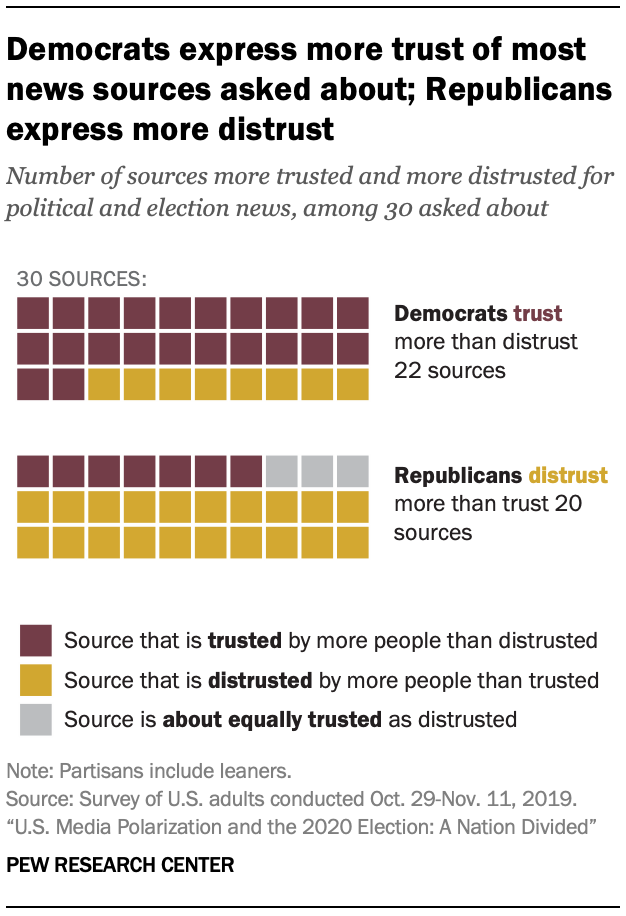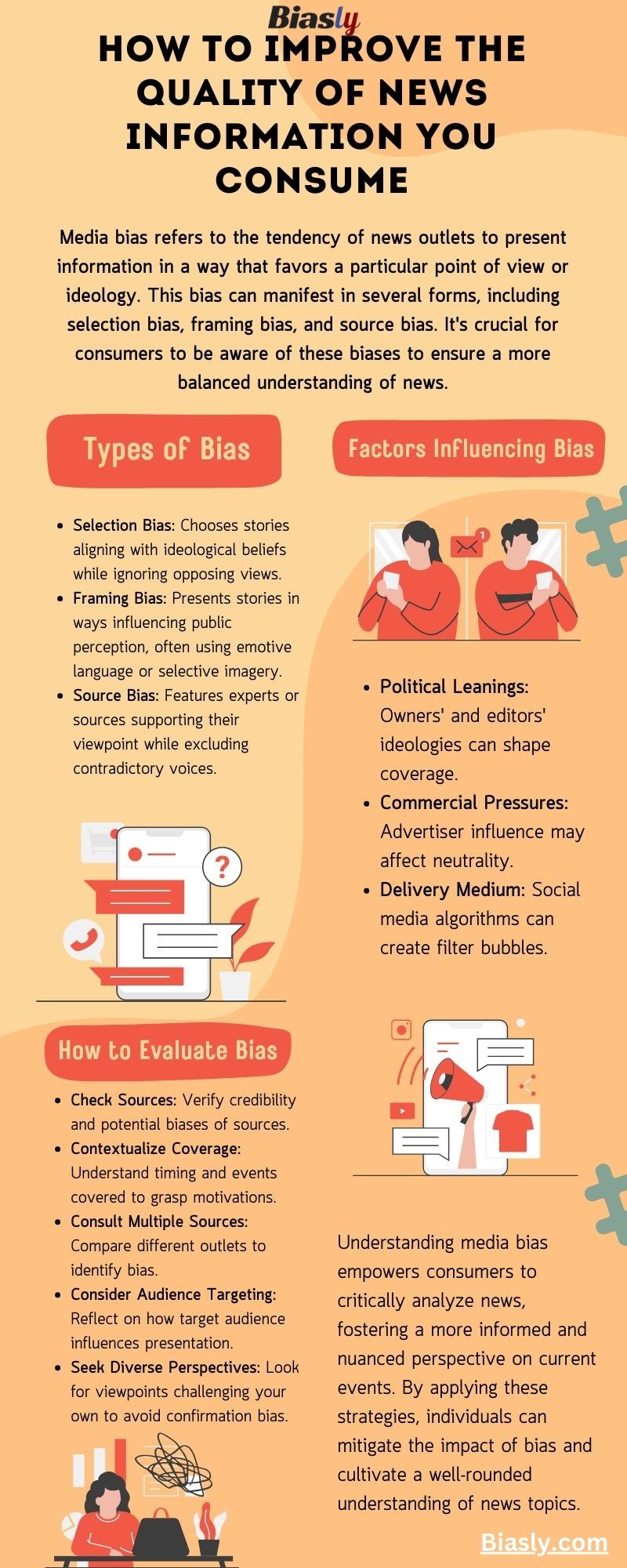
One way to improve the quality of the news information you consume is to seek out news from various sources. This can counteract the effects of media bias by exposing you to a diversity of perspectives and viewpoints. For example, you typically read news from a single outlet. In that case, consider reading news from other outlets with different political leanings to get a more well-rounded view of events. Additionally, subscribing to newsletters or news aggregators, such as Biasly.com that select news from various sources is also an excellent way to access many perspectives. Another way to improve the quality of the news you consume is to fact-check information.
Fact-checking can be completed through websites such as Biasly.com, which can help you determine the accuracy of information. Additionally, you can use Google or other search engines to research a source’s credibility or find additional information on a topic. Another way to improve the quality of the news information you consume is to be aware of the language used in news stories. News outlets may use specific vocabulary or framing to shape public opinion. Knowing this can help you identify when a story is being presented in a way intended to influence your opinion. For example, suppose a news outlet uses emotive or sensationalistic language to describe a particular issue. In that case, this may indicate that the story is being presented in a way intended to generate fear or anxiety.
How Political Leanings Influence News Media
Additionally, It is essential to be aware of the context of the news you are consuming, such as the timing and location of the reported events. This can help you to understand the motivations behind the information and the potential biases of the sources. Another way to improve the quality of the news information you consume is to be aware of the agendas of the news outlets. News outlets may have different agendas, such as to inform, entertain, influence public opinion, or make a profit. Knowing the agendas of the news outlets can help you understand the news’s context and the sources’ potential biases.
Eventually, it is paramount to be aware of the news you consume and not take everything at face value. This means being skeptical of sensational headlines or claims that seem too good (or wrong) to be true. Pew Research finds that “CNN is trusted by 70% of self-described liberal Democrats, but only 16% of conservative Republicans – a gap of 54 percentage points. Conversely, Fox News is trusted by 75% of conservative Republicans but only 12% of liberal Democrats – a 63-point gap”. Additionally, it is a good idea to cross-reference news stories with other sources to ensure that the information is accurate and that you are not being misled by bias or misinformation.
In Conclusion, there are several ways to improve the quality of your news information.
- Seeking out news from a variety of sources, fact-checking information, being aware of the language used in news stories, being mindful of the context of the news, being aware of the agendas of the news outlets, and being critical of the info you consume can all help to improve the quality of the news information you consume.
- Additionally, it is crucial to be aware of the potential biases of news outlets and to seek out news from a variety of sources in order to get a well-rounded view of events. By taking these steps, you can help to ensure that you are consuming accurate and reliable news rather than being misled by bias or misinformation.
Hence, it’s essential to be critical and open-minded when evaluating claims about media bias and to consider the evidence and context before concluding. News media bias refers to the tendency of news outlets to present news and information in a way that favors a particular point of view or ideology. This bias can take various forms, including selection bias, framing bias, and source bias. Typically, Democrats express more trust in the news than Republicans do as noted by a Pew Research study conducted in 2020:

Source: Pew Research
Types of Bias
Selection bias refers to the process of choosing which stories to cover and which to ignore. News outlets may choose to cover stories that align with their ideological beliefs and ignore stories that do not. For example, a conservative news outlet may choose to cover stories that portray the actions of the police positively while ignoring stories of police brutality. Similarly, a liberal news outlet may choose to cover stories that focus on the negative impacts of climate change while ignoring stories that question the existence of climate change.
Framing bias occurs when news sources present stories in a way that influences how the public perceives the topic. This can be done through the use of certain language or imagery, like using emotionally charged words to generate fear or utilizing particular clips of a demonstration without providing the full context of what happened. For instance, a news outlet may show footage of a protest that appears peaceful while omitting the moments of violence that occurred at the same event.
Source bias refers to the types of experts or sources that news outlets choose to include in their stories. News outlets may choose to have experts or authorities that align with their ideological beliefs and ignore those that do not. For example, a conservative news outlet may include experts who support using fossil fuels while ignoring experts who advocate for renewable energy. Similarly, a liberal news outlet may choose to have experts who advocate for government intervention in the economy while ignoring experts who support free-market solutions. Bias in the news media can be influenced by various factors, including the political leanings of the outlet or its owners and commercial and other pressures. For example, a news outlet that a corporation owns may be more likely to present news in a way that aligns with the owner’s beliefs, as reported by Yale in its media research. Similarly, a news outlet that is heavily dependent on advertising revenue may be more likely to present news in a way that pleases its advertisers.
Deepen Your Understanding of Bias
Moreover, bias in the news media can also be influenced by the way the news is delivered, such as how easy it is to access and the medium used. For example, social media platforms have been a primary news source for many people; these platforms use algorithms that personalize the news feed for each user. This can lead to a phenomenon known as filter bubbles, which refers to the way in which people are exposed to news and information that is consistent with their pre-existing beliefs and values and can lead to the reinforcement of bias.
In conclusion, news media bias is the tendency of news outlets to present news and information in a way that favors a particular point of view or ideology. This bias can take various forms, including selection bias, framing bias, and source bias. It can be influenced by multiple factors, such as the political leanings of the outlet or its owners, commercial pressures, and the delivery medium. It is important for news consumers to be aware of bias and seek out news from various sources to get a well-rounded view of events.
How to check for Media Bias
There are several ways you can evaluate claims about media bias:
- Check the sources: Look for evidence to support the claim, such as quotes from media outlets or experts, statistics, or data. Be sure to verify the credibility of the sources and consider if they have a stake in the issue being discussed. One way to do this is by using the Media Rating List.
- Consider the context: Consider the context in which the media coverage is occurring, such as the timing of the coverage or the specific events being covered. This can help you understand the motivations behind the media’s decisions.
- Look at multiple sources: Don’t rely on just one source for your information. Instead, look at coverage from various outlets and consider whether there is a consistent bias or if the bias varies from outlet to outlet.
- Consider the audience: Consider who the media outlet is targeting and how this may influence the bias of the coverage.
- Seek out diverse perspectives: Don’t rely on sources confirming your biases. Seek out diverse perspectives and consider how they may challenge or broaden your understanding of the issue. Check the side by side news by using the Side-by-Side-News-Bias-Comparison
























